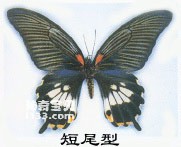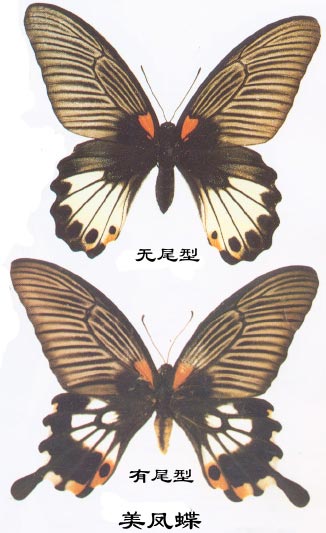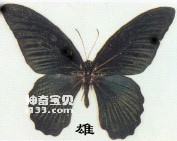For some species of butterflies, the color patterns of male butterflies are similar, but the female butterflies are very varied and very different. For example, some have tail protrusions, some have no tail protrusions, and there are many different color patterns and shapes. The Papilion butterfly is a representative species of the above-mentioned female polymorphism, so it is also called the polymorphic blue swallowtail butterfly and the polymorphic Papilio butterfly.

Wingspan 105~145 mm. Male and female dimorphism and female polymorphism. The body and wings of the male butterfly are black. The bases of the front and rear wings are dark in color and have a velvety luster, and the wings are blue-black on both sides. On the opposite side of the wing, the base of the middle chamber of the fore wing is red, and the veins on both sides are grayish white; there are 4 red spots of different shapes on the base of the hind wing, and there are 2 rows of annular spots composed of blue scales in the sub-peripheral area, but the outline is unclear; the hip angle There are annular or semi-ring erythema spots, and there are meniscus-shaped erythema spots on the inner side, namely cu2 and cu1 chambers, without tail process. The base of the female tail-less forewing is black, the base of the middle chamber is red, the veins and leading edge are dark brown or black, and both sides of the veins are gray brown or gray yellow. The base half of the hind wings is black, and the tip half is white, with long triangular spots divided by veins. The sub-peripheral area is black, the outer edge is wavy, and there are oblong black spots at and near the hip angle. The front wing on the reverse side is similar to the front wing; there are 4 red spots of different shapes on the base of the hind wing, and the rest are similar to the front wing. The female has a tail-shaped forewing similar to the tail-less type. In addition to a white spot at the end of the middle chamber, the hind wings have a white spot in each wing chamber in the middle area of the wing. Sometimes the white spot disappears near the front edge; the outer edge is wavy. , with red or yellow-white spots in the trough; oblong black spots on the hip corners, surrounded by red. The reverse side of the wings and the front wings are similar to those on the front side. The hind wings are similar to the front except that there are 4 red spots at the base.

Oval, orange-yellow. The diameter is about 1.7mm and the height is about 1.5mm.
The head of the larvae is initially dark brown, becomes lighter as it grows, and turns green when mature. The body of the 1st to 3rd instar larvae is olive green, with oblique white stripes on the 2nd to 4th abdominal segments connecting on the back, and white stripes on the 7th to 9th abdominal segments extending to the back. The body color of the 4th instar larvae turns green-brown, and the white stripes on the back disappear. Mature larvae have white diagonal bands on the 4th and 5th abdominal segments, sometimes connected on the back, with small black and green stripes on the bands. There is also a same color mark on the side of the 6th abdominal segment. Valve brown. The stinkhorn is light orange-white in its first instar, becomes darker as it grows, and turns orange-red in its final instar.

The ends of a pair of protrusions in front of the pupal head are arc-shaped, and the rear edge of the third abdominal segment and the front edge of the fourth abdominal segment protrude to both sides. The green pupae have broad, diamond-shaped yellow-green stripes on the back, and brown irregular markings on the wings; the brown pupae have markings like wood textures, and the stripes on the wings resemble moss.
Host: Citrus spp., Zanthoxylum nitidum, Z. ailanthoides and other plants of the Rutaceae family.
Biology: Adult butterflies love to visit flowers to collect nectar. Male butterflies have strong flying ability and are very lively. They often fly wildly in the wilderness. Female butterflies fly slowly, often gliding. The Taiwanese subspecies is found throughout the province from flatlands to mountainous areas with an altitude of 2,500m. More than three generations occur in one year, and they overwinter as pupae. Adults appear throughout the year, with the main occurrence period from March to November. The egg stage lasts 4-6 days, the larval stage lasts 21-31 days, and the pupa stage lasts 12-14 days. Adults lay eggs singly on the twigs of the host plant or on the underside of leaves, and the mature larvae pupate on the twigs of the host plant or other nearby plants. Adult insects often appear in garden flowers and often fly along fixed routes to form butterfly pathways.
Distribution: This species is a southern species in my country, mostly found in provinces south of the Yangtze River, such as Sichuan, Yunnan, Hubei, Hunan, Zhejiang, Jiangxi, Hainan, Guangdong, Guangxi, Fujian, Taiwan; Japan, Sikkim, India, Myanmar, Thailand, and Sri Lanka .
animal tags:
We created this article in conjunction with AI technology, then made sure it was fact-checked and edited by a Animals Top editor.